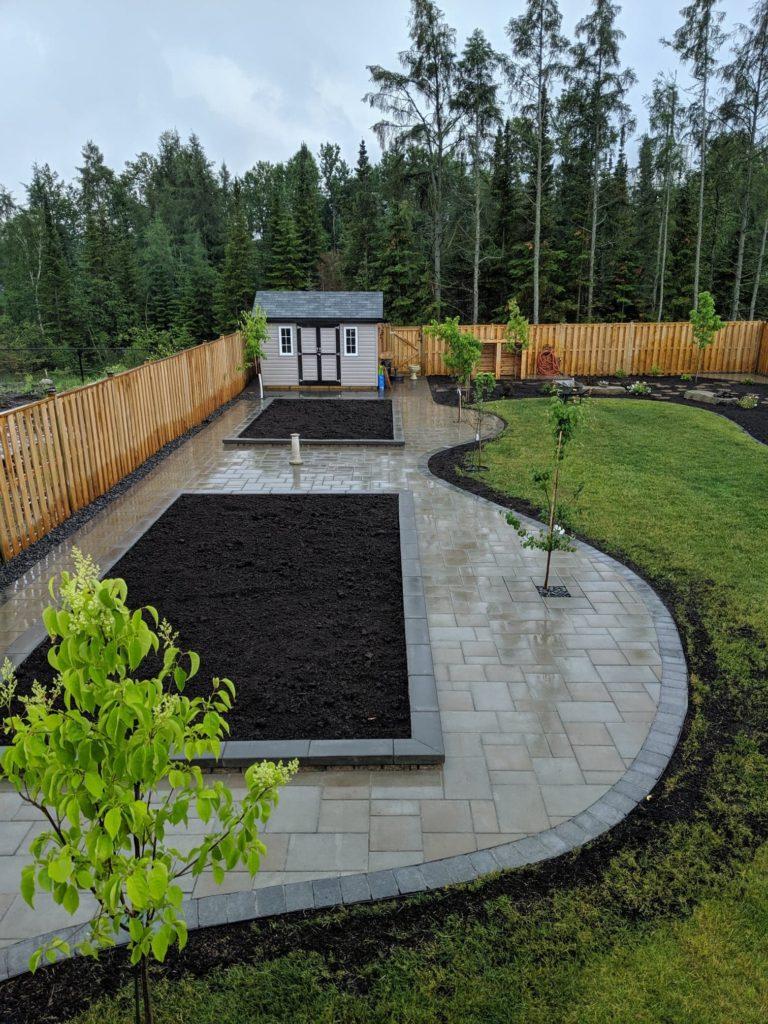Our Blogs

What Is The Best Time Of Year For Landscaping?
The best time of year for landscaping is in the fall, particularly from late summer through early fall. Choosing the best time of year for landscaping can make a significant difference in the success and health of your outdoor spaces. While each season has its advantages, fall stands out as the optimal time for many landscaping activities.
Understanding why fall is ideal and how to leverage it for your landscaping projects can help you achieve a beautiful, thriving yard. This guide will explore the benefits of fall landscaping and offer tips for year-round planning to ensure your landscape flourishes. At MD Landscape & Design, we are committed to helping you create stunning outdoor environments, no matter the season. Here are key reasons why:
Key Takeaways:
Fall is the best time for landscaping due to favorable weather and optimal root development.
Cooler temperatures and mild humidity reduce stress on plants.
Fall planting allows for more mature landscapes by the following spring.
There is less competition for popular plant varieties in the fall.
Hardy plants thrive with fall planting and have time to establish strong roots.
Benefits of Fall Landscaping: Why It's Ideal for Planting
Fall is an ideal time for landscaping due to several key benefits that promote healthy plant growth and a thriving outdoor space. Here are some reasons why fall is perfect for planting:
Optimal Root Development: Fall planting allows trees, shrubs, and perennials to establish strong root systems before the dormant winter period. These well-developed roots will support robust growth in the spring, ensuring healthier and more resilient plants.
Favorable Weather Conditions: The cooler temperatures and increased rainfall in the fall reduce stress on newly planted vegetation. Unlike the scorching heat of summer, fall’s mild weather provides an ideal environment for plants to take root and thrive.
Extended Growing Period: Landscaping in the fall gives plants more time to grow and mature before the spring growing season. This head start means your landscape will look fuller and more established when spring arrives.
Reduced Pest and Disease Pressure: Many pests and diseases that affect plants are less active in the fall. Planting during this season reduces the risk of infestations and infections, allowing your plants to establish themselves without the added stress of battling pests.
Better Plant Availability: Nurseries often have a wide selection of plants in the fall, and many offer discounts as they prepare for the end of the planting season. This means you can find high-quality plants at a lower cost, making it an economical choice for landscaping.
Less Competition for Resources: In fall, there is generally less competition for water and nutrients in the soil, as the intense growth period of spring and summer has passed. This allows your new plants to access the resources they need to establish strong root systems.
Improved Soil Conditions: Fall's cooler temperatures and increased moisture content improve soil conditions, making it easier to work with. Soil that is too dry in the summer or too wet in the spring can be challenging to prepare, but fall provides a balanced environment for soil preparation.
By taking advantage of these benefits, you can ensure your landscaping efforts are successful and your plants thrive. Fall landscaping sets the stage for a beautiful and healthy garden come spring.
Spring vs. Fall: When Should You Landscape Your Yard?
Choosing the right season for landscaping your yard can greatly impact the success and health of your plants. Both spring and fall have their unique advantages and challenges. Here’s a comparison to help you decide when to landscape your yard:
Benefits of Spring Landscaping:
Active Plant Growth: Spring is a period of rapid growth for many plants. The increasing daylight and warmer temperatures stimulate new growth, making it an ideal time for planting.
Wide Plant Selection: Nurseries are typically stocked with a wide variety of plants in the spring. You’ll have access to fresh inventory, which means more options to choose from for your landscape design.
Immediate Visual Impact: Planting in the spring allows you to enjoy the beauty of your new plants right away. The immediate visual impact can be rewarding as flowers bloom and foliage fills out.
Longer Growing Season: By planting in the spring, your plants have the entire growing season to establish themselves before facing the harsher conditions of winter.
Early Start for Vegetables and Herbs: Spring is perfect for starting vegetable and herb gardens. Planting early in the growing season gives these plants ample time to mature and produce a bountiful harvest.
Benefits of Fall Landscaping:
Optimal Root Development: Fall planting allows plants to focus on root development rather than top growth. Cooler soil temperatures encourage strong root systems, leading to healthier plants in the long run.
Favorable Weather Conditions: Fall’s cooler temperatures and increased rainfall reduce stress on new plantings. The mild conditions are ideal for establishing new plants without the intense heat of summer.
Reduced Pest and Disease Pressure: Many pests and diseases are less active in the fall, reducing the risk of damage to newly planted vegetation. This creates a healthier environment for plant establishment.
Better Plant Prices: Nurseries often offer discounts on plants in the fall as they clear out inventory for the season. This can make fall landscaping more cost-effective.
Less Competition for Resources: With fewer plants actively growing in the fall, your new plantings face less competition for water and nutrients in the soil, helping them to establish more easily.
Both spring and fall offer unique benefits for landscaping. Spring is ideal for quick growth and immediate visual impact, while fall provides optimal conditions for root development and reduced stress on new plants.
Planning Ahead: Seasonal Landscape Design for Year-Round Enjoyment
Creating a landscape that is beautiful and functional throughout the year requires careful planning and consideration of each season's unique characteristics. By designing with all four seasons in mind, you can ensure your outdoor space remains vibrant and inviting year-round. Here are some key strategies for achieving seasonal landscape design:
1. Spring: Renew and Rejuvenate
Spring Bloomers: Incorporate early-blooming flowers like tulips, daffodils, and crocuses to add vibrant color after the winter months.
Fresh Foliage: Choose deciduous trees and shrubs that produce fresh green leaves in spring, providing a lush backdrop for your garden.
Seasonal Maintenance: Spring is the perfect time for pruning, mulching, and preparing your garden beds for the growing season.
2. Summer: Thriving and Flourishing
Heat-Tolerant Plants: Opt for drought-resistant plants such as succulents, ornamental grasses, and native species that can withstand summer heat.
Shade and Shelter: Plant trees and shrubs that provide shade and create cool, comfortable outdoor living spaces.
Water Features: Incorporate elements like fountains or ponds to add a refreshing touch and help cool the surrounding area.
3. Fall: Warmth and Color
Autumn Hues: Select trees and shrubs with striking fall foliage, such as maples, oaks, and dogwoods, to create a stunning display of reds, oranges, and yellows.
Late Bloomers: Include perennials like asters, chrysanthemums, and sedums that bloom in late summer and fall, extending your garden's color into the cooler months.
Seasonal Cleanup: Fall is the time to tidy up your garden, rake leaves, and prepare plants for winter dormancy.
4. Winter: Structure and Texture
Evergreens: Incorporate evergreen trees and shrubs to provide structure and color during the winter months when many plants are dormant.
Bark and Berries: Choose plants with interesting bark, like birch or red-twig dogwood, and those that produce winter berries, such as holly or winterberry, to add visual interest.
Hardscaping Elements: Use stone pathways, benches, and garden sculptures to add texture and focal points to your winter landscape.
Weather Considerations: How Climate Affects Your Landscape Timing
Understanding how climate impacts your landscape timing is crucial for creating a thriving outdoor space. Different weather conditions can significantly influence when and how you should plan your landscaping projects. Here are some key weather considerations to keep in mind:
1. Temperature Fluctuations
Spring Planting: In regions with cold winters, it's important to wait until the last frost date has passed before planting. Early spring can be unpredictable, and young plants are vulnerable to frost damage.
Fall Planting: In climates with mild winters, fall is ideal for planting as cooler temperatures allow for root establishment without the stress of summer heat. However, in areas with early frosts, planting should be completed before the first frost date.
2. Precipitation Patterns
Rainfall: Consistent rainfall is beneficial for newly planted vegetation. Plan your landscaping projects during seasons with moderate to high rainfall to reduce the need for supplemental watering.
Drought Conditions: In arid climates, consider xeriscaping with drought-tolerant plants that require minimal water. Avoid planting during the hottest, driest months to reduce stress on new plants.
3. Seasonal Extremes
Summer Heat: In hot climates, summer planting can be challenging due to extreme temperatures and increased water requirements. Opt for planting in early spring or late fall to avoid peak heat.
Winter Cold: In regions with harsh winters, avoid planting late in the fall when the ground may freeze. Ensure plants have enough time to establish roots before winter dormancy.
4. Wind Exposure
Windbreaks: In areas prone to strong winds, consider planting windbreaks such as trees or shrubs to protect your garden. This can reduce soil erosion and physical damage to delicate plants.
Sheltered Planting: Choose sheltered locations for new plantings to protect them from wind desiccation and damage, particularly during the initial growth phase.
5. Humidity Levels
High Humidity: In humid regions, select plants that are resistant to fungal diseases and root rot. Ensure proper spacing and air circulation to prevent moisture buildup around plants.
Low Humidity: In dry climates, mulch can help retain soil moisture and protect plants from rapid drying. Choose plants adapted to low-humidity conditions.
Fall Landscaping Tips: Preparing Your Yard for Winter
Preparing your yard for winter is essential to ensure that your plants and landscape thrive when spring arrives. Fall is the perfect time to take the necessary steps to protect and maintain your yard. Here are some key fall landscaping tips to help you get ready for winter:
1. Clean Up Your Garden:
Remove Debris: Clear fallen leaves, branches, and other debris from your garden beds and lawn. This prevents pests and diseases from taking shelter and spreading.
Cut Back Perennials: Trim back perennials to about 6 inches above the ground to encourage healthy growth in the spring. Leave some plants with seed heads to provide food for birds.
2. Mulch and Protect Plants:
Apply Mulch: Spread a layer of mulch around the base of trees, shrubs, and perennials. This helps to insulate the soil, retain moisture, and protect roots from freezing temperatures.
Protect Delicate Plants: Cover sensitive plants with burlap or frost cloth to shield them from harsh winter winds and frost.
3. Care for Your Lawn:
Aerate the Soil: Aerate your lawn to relieve soil compaction and improve water and nutrient absorption. This promotes stronger root growth.
Fertilize: Apply a slow-release fertilizer to your lawn to provide essential nutrients that will support root development during the winter months.
Reseed: Overseed thin or bare areas of your lawn to ensure a lush, green yard in the spring.
4. Prepare Trees and Shrubs:
Prune Dead Branches: Prune any dead or diseased branches from trees and shrubs to prevent damage during winter storms.
Wrap Young Trees: Protect young or newly planted trees with tree wraps or guards to prevent damage from frost and animals.
5. Plan for Spring:
Plant Bulbs: Plant spring-flowering bulbs such as tulips, daffodils, and crocuses in the fall. This ensures a colorful and vibrant garden in the early spring.
Prepare Garden Beds: Clean and amend garden beds with compost or organic matter to improve soil structure and fertility for next year's planting.
FAQs
1. Can I landscape in the winter?
Yes, certain landscaping projects can be done in the winter, such as planning, designing, and hardscaping. Planting winter-hardy trees and shrubs is also possible.
2. What are the benefits of fall landscaping?
Fall landscaping offers optimal root development, favorable weather conditions, reduced competition for plants, and a head start for the following spring.
3. How can I protect my plants in the summer heat?
To protect plants in the summer, choose drought-tolerant varieties, mulch to conserve moisture, and water deeply and consistently.
4. What are some low-maintenance plants for landscaping?
Low-maintenance plants include native species, ornamental grasses, succulents, and perennials that are well-suited to your climate.
5. How do I prepare my garden for winter?
Prepare your garden for winter by pruning, mulching, protecting sensitive plants with coverings, and ensuring proper drainage to prevent waterlogging.
Transform Your Landscape with MD Landscape & Design
Fall is undoubtedly the best time for landscaping, offering optimal conditions for plant growth and establishment. At MD Landscape & Design, we understand the unique advantages of fall planting and are here to help you create a beautiful, thriving outdoor space. Whether you're looking to plant trees, shrubs, or perennials, fall provides the perfect opportunity to set your landscape up for success.
Contact us today to schedule a consultation and let our expert team bring your vision to life. Don't wait—fall is the perfect time to start your landscaping project. Reach out to us now and take the first step towards a breathtaking landscape.
Connect with us!

1155 Waterford St, Thunder Bay, ON, CA
info@mdlandscape.ca
Hours:
Monday-Friday from 09:00 AM-5:00 PM
Saturday -Sunday: Closed
COMPANY
INQUIRIES
LANDSCAPING AWARDS



